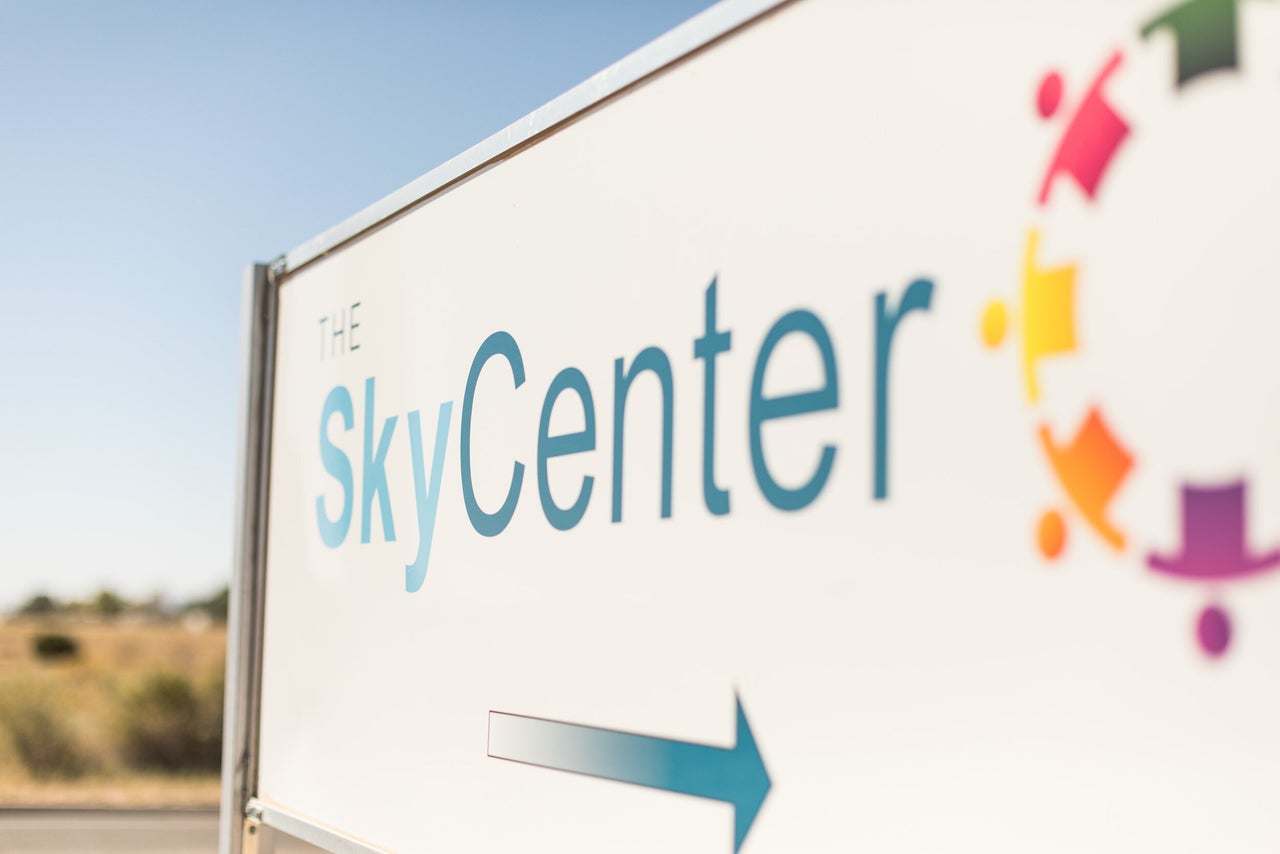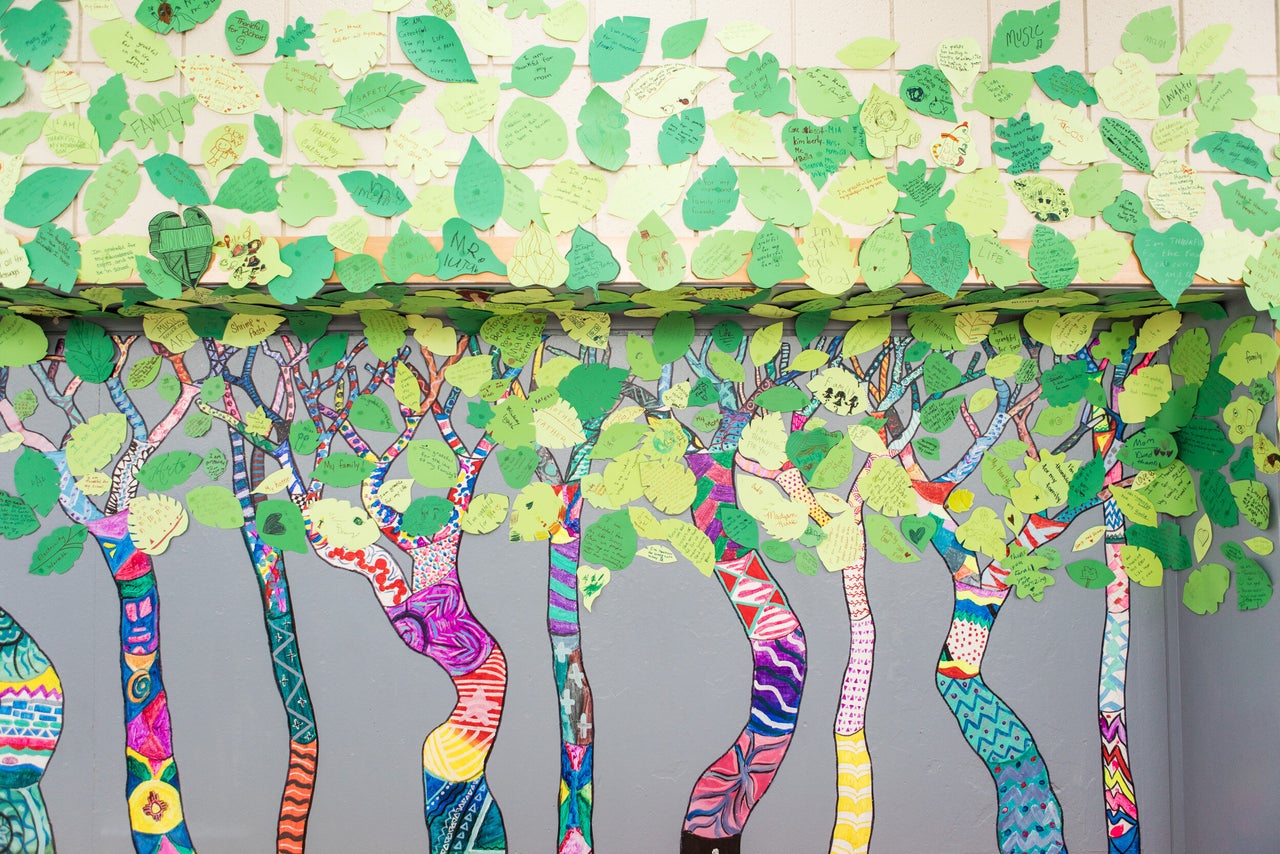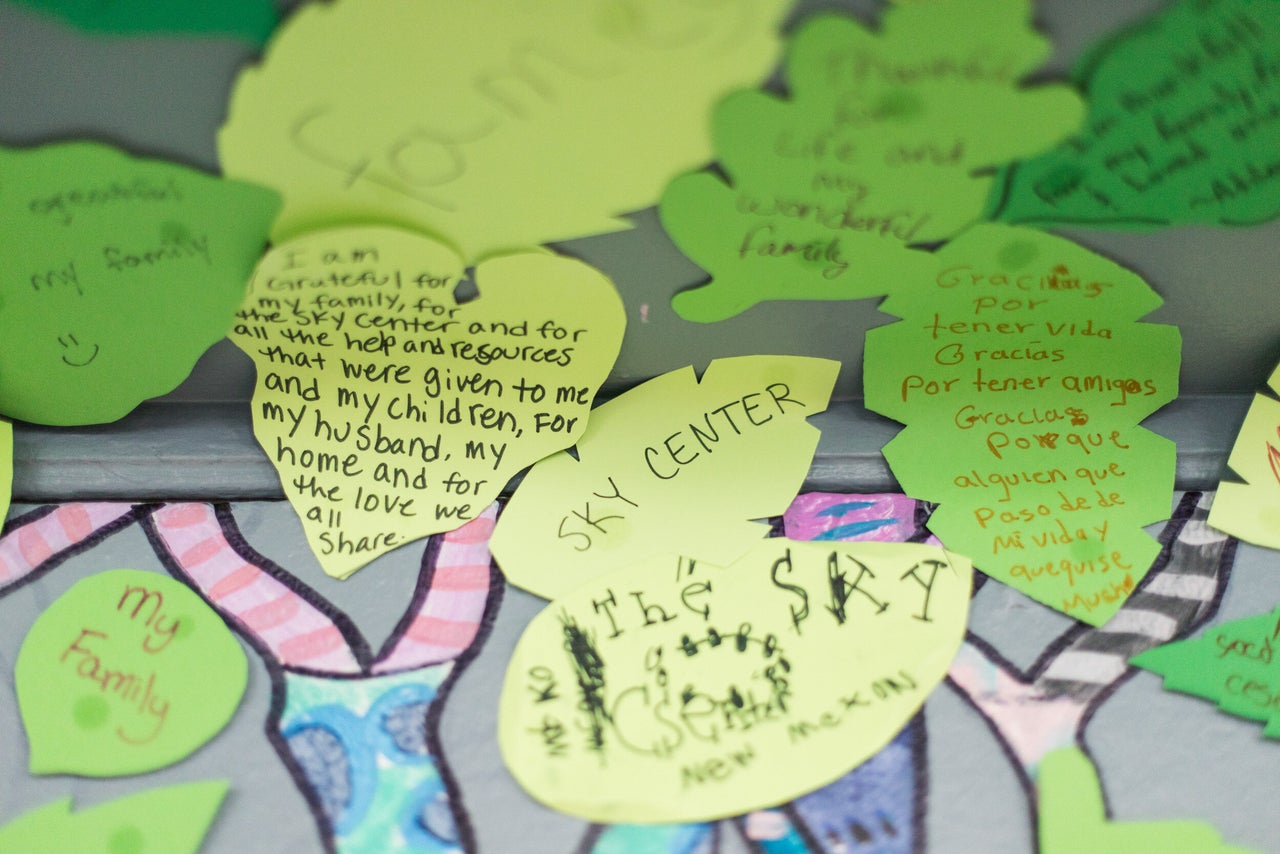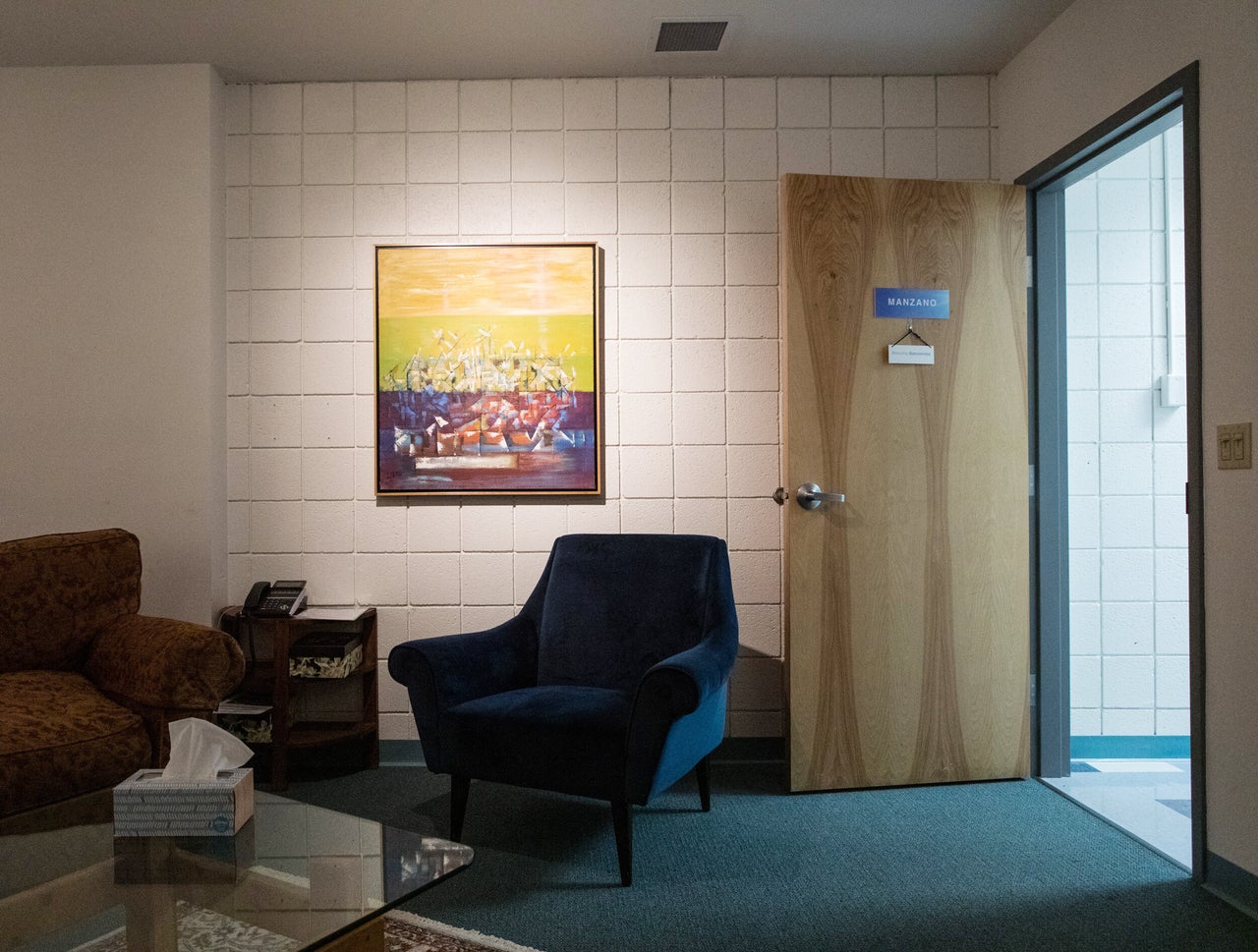SANTA FE, N.M. ― As with most after-school clubs, the meeting inside Ortiz Middle School begins with kids bumping and jostling into a classroom. A boy with green hair grabs a bag of chips off a table, taking a seat next to a girl. He invites her to share the snack. Another student adjusts the tie-dye bandana she’s using as a headband and shows her friend a funny meme on her phone.
The adult advisers, Robert Kristy and Katrina Koehler, ask everyone to take a seat on the floor in a circle, assuring them that pizza has been ordered and will be delivered shortly.
Koehler asks, “So, on a scale of happy to crappy, how’s your suicide?”
Forget the volleyball team or chess club. This group, which has been meeting weekly since 2015, was formed in the spirit of Project Semicolon, an international movement that began when activist Amy Bleuel shared her mental health struggles on social media. “[E]veryone who self harms, is suicidal, depressed, has anxiety, is unhappy, going through a broken heart, just lost a loved one, etc. draw a semicolon on your wrist,” she posted to Twitter in 2013. “[A] semicolon represents a sentence the author could’ve ended, but chose not to. [T]he author is you and the sentence is your life.”
All over the world, people embraced the punctuation mark, with many acquiring real semicolon tattoos. The Sky Center, an independent mental health clinic that operates out of Ortiz Middle School, also adopted the semicolon for a suicide survivors group created as part of its effort to provide free, in-person support to a growing number of distressed young people.

For years, experts across the United States have been working to address the mental health crisis among teens and young adults. But a growing number of indicators suggest that the same emotional problems ― anxiety, depression and even suicide ― are affecting children at increasingly younger ages.
Even before the onset of the coronavirus pandemic, there were worrying signs. The number of anxiety disorders diagnosed by health care providers in children as young as 6 has gone up 17% in just five years, according to the most recent data.
Self-injury, or intentional cutting, scratching, burning or hitting, has been measured as high as 30% in some populations of girls, with the age of onset around 12 or 13.
These intentional self-harming behaviors ― often separate from suicidal intentions ― have become so widespread that a new disorder, non-suicidal self-injury (NSSID), was added to the 2013 DSM-5.
Bark, an app that alerts parents when their children encounter worrisome content online, analyzed the online activity of more than a million tweens in 2019. A staggering 55% of them had conversations about depression, and 35% were involved in self-harm or suicide situations.
“We’ve crossed a threshold,” said Apryl Miller, executive director of the Sky Center and an innovator in youth mental health services. “All of the emotional difficulties and peer relationship issues we used to see with 16-, 17-, 18-year-olds, now we see those exact same stressors in younger kids. We regularly get parents calling up with the kind of situation that used to be unimaginable. They say, ‘I’m worried about my 10-year-old and they mentioned suicide.’”
According to the Centers for Disease Control and Prevention, suicide is now the second leading cause of death among children ages 10 to 14, killing more Americans those ages than every type of cancer combined.
Surviving Their ‘10-Ness’
The Sky Center, a cozy area tucked away at the rear of a school where over 90% of students identify as Hispanic and 100% of the students qualify for free lunch, glows with fairy lights nestled within a forest of construction-paper trees. Each week, the Semicolon kids gather here, arranging themselves in a loose circle on couches and pillows to talk about their week, and experience something increasingly hard to come by in the modern world: community connection.
In a session I attended in March, the students took turns answering Koehler’s question about their current suicidal status, with “10” meaning close to suicide and “1” being not suicidal at all. A 12-year-old boy who was referred to the center said he was feeling “10” — describing how someone he’d considered a friend had been bullying him over Instagram and Snapchat. “It really, really affected me bad,” he said.
“I’m so sorry!” came the sympathetic reply from Koehler, who has a beatific presence and has spent nearly 20 years running Gerard’s House, a grief counseling center that co-sponsors the Semicolon group.

Between bites of a McDonald’s cheeseburger, an eighth grade girl also assessed herself at “10.” She had been raped the previous year, and was feeling anxious and stressed as the trial date approached, becoming increasingly fearful about leaving her house. “I’m afraid of going outside,” she said. “Even if I’m with friends, I feel like there are men watching me, and they could rape me.”
A young trans boy, with bleached bangs and rainbow laces woven into his black high-tops, also rated himself as a “10.” His mother disapproves of his identity and they are in frequent conflict; he has also been in and out of shelters. The boy pulled up his left sleeve to show the group where, earlier in the day, he had burned five holes into his skin using the pointy ears of a plastic Yoda toy.
Throughout the meeting, Koehler and the students gave their full attention to each speaker, offering compassionate nods and words of understanding. They shared inside jokes and, occasionally, hugs or commiserating laughs. Having repeated this ritual many times, becoming familiar with the intimate details of one another’s stories, the group provides safety and connection, a place where these kids, and all their feelings, are accepted unconditionally — no matter how dark or messy.
“There are so many screens everywhere. Our brains and bodies aren’t able to process the constant onslaught of media and information.”
- Heidi Boisvert, City University of New York
Koehler is careful to intervene when necessary. She told the trans boy, for example, that they needed to speak privately afterward, so she could assess how best to address his self-harm. But her primary focus is acknowledging the magnitude of the students’ experiences in the present ― not treating their pain as a problem to be hurriedly solved. “You’ve had a really rough week,” she said. “I just want to say how happy I am that you guys survived your 10-ness.”
As the rates of youth with mental health problems reach record levels, and the number of kids diagnosed with developmental disorders continues to grow, researchers have been clamoring to identify the root causes. The proliferation of mobile phones, social media and other digital technologies is often blamed, although as scientists are quick to remind us, correlation does not equal causation. But a recent report from Common Sense Media, “Tweens, Teens, Tech, and Mental Health: Coming of Age in an Increasingly Digital, Uncertain, and Unequal World 2020,” documents the prominent and multifaceted role that tech plays in children’s lives, influencing nearly every aspect of their relationships and development.
“There are so many screens everywhere. Our brains and bodies aren’t able to process the constant onslaught of media and information,” says Heidi Boisvert, a researcher and creative technologist at the City University of New York.
Boisvert has been working for more than a decade to understand how media consumption affects humans on a neurobiological level, measuring limbic and parasympathetic nervous system responses to various types of digital content. What she’s discovered is alarming: “All the time we spend online is causing us to be in a near-constant state of fight or flight.”

At the same time we’re all spending more hours online, we’re spending fewer hours sharing experiences with other people in real life. From the shift away from community groups that Robert Putnam described in 1995 as “bowling alone,” to the Gallup-measured drop of 20 percentage points since 1999 in the number of adults who belong to a church, synagogue or mosque, it would be hard to overstate how profoundly the social fabric of American life has changed.
“All this stuff that keeps human beings human, that’s all disappearing,” says Nathan Morell, a staff therapist at Stockton University, referring to real-life social networks, the method by which humans have built and sustained emotional well-being for millennia. Undergirding this “crisis of connection,” as New York University psychologist Niobe Way describes it, are historic rates of poverty and the grinding consequences of racism, each of which already causes toxic stress.
According to Boisvert and other experts, the decline of face-to-face communication is having a direct effect on how our brains learn to process feelings and emotions. “All of this grazing on content disrupts critical brain functions that are responsible for emotional activation and regulation,” she said. One such function is memory consolidation, the process by which neurons collect and store information into a cohesive, reliable body of emotional and intellectual knowledge. By receiving so many fragments of decontextualized information, the consolidation process is essentially being hijacked.
“Because we’re grazing content, it’s actually not imprinting on the brain,” Boisvert explained. “It’s light learning instead of deep processing. The more time we spend watching screens,” she added, “the more we are unconsciously training ourselves to be socially and emotionally incompetent.”
A Few Gentle Words
Of course, digital technologies can provide new lifelines, too. Common Sense Media’s mental health report notes how social media and online communities offer “distinct benefits for young people who are excluded or feel stigmatized in their offline peer groups due to ethnic, racial, or gender or sexual minority status,” such as resource sharing and emotional support. But marginalized groups face other factors that render those benefits uneven.
“Adolescents growing up in lower-income households not only have less reliable devices and means of connecting to online spaces” — a deprivation that’s been underscored during the pandemic — “they also tend to receive less supervision, support, and scaffolding in their online activities, and report more spillover of negative online experiences,” the report notes. Crucially, for youngsters with pre-existing vulnerabilities, time spent online presents exacerbated risks.
The report concludes with recommendations for parents and caregivers that are similar to how mental health experts treat anxiety and depression: Initiate discussions, be emotionally present, and share these moments not via text, but in real life — a type of engagement that provides emotional nourishment beyond the fleeting dopamine hit of a “like.”

Authentic shared experiences are what occur at the Sky Center, which relies on donations to keep services free for anyone in need. Rather than treat individual children, the center utilizes what’s known as family systems therapy, an approach that helps everyone in a family unit recognize the impact of their behavior on others and develop healthy, productive problem-solving strategies.
In the 12-month period ending June, the center provided counseling to 371 at-risk youth and their families, about triple the number during the 2010-11 school year. Those figures don’t include scores of parents, siblings, relatives and other adults who also attended therapy, receiving lessons in self-regulation and empathetic social interaction ― what the Sky Center calls “inner and outer life skills.” (A growing number of educators refer to this as “SEL,” or social and emotional learning.)
On any given day, students come and go, counselors lead dual midday group meetings for at-risk sixth- and eighth-grade girls, a dozen families rotate in and out of session rooms, and Miller oversees Natural Helpers, a peer support training program the Center operates for students from eight area middle and high schools. Erin Sibley Doerwald, the program director, might lead a one-hour check-in session with the staff of graduate interns to make sure they are tending to their own well-being so as to minimize the effects of secondary trauma. Otis, a therapy dog, walks around and nuzzles visitors. Koehler and Kristy might be making calls to struggling children or their family members, whether to inquire about an absence or just to check in.
Kristy, an affable 59-year-old social worker and one of the advisers, has worked at the Sky Center since 2011. He says he believes children with mental health issues are indicators of larger problems in families, communities and our nation. “The kids are symptom bearers,” Kristy said. “Suicidal feelings are a lightning rod. It’s their way of saying ‘Something is rotten in Denmark.’”
Instead of ending their lives, however, these children have decided to work for change, and they are changing and healing their families alongside themselves. With nothing more simple ― or more profound ― than a few gentle words or an acknowledgement of pain, lives are transformed, and, often, saved.
One teen, the one with green hair, right before the meeting started, said of the Semicolon group: “I’ve absolutely fallen in love with it. It’s given me a place to escape when things aren’t great.”
If you or someone you know needs help, call 1-800-273-8255 for the National Suicide Prevention Lifeline. You can also text HOME to 741-741 for free, 24-hour support from the Crisis Text Line. Outside of the U.S., please visit the International Association for Suicide Prevention for a database of resources.
Julie Scelfo is a New York City-based journalist and advocate. She is a former staff writer at The New York Times and the author of “The Women Who Made New York.” More info about her work is at www.juliescelfo.com.
